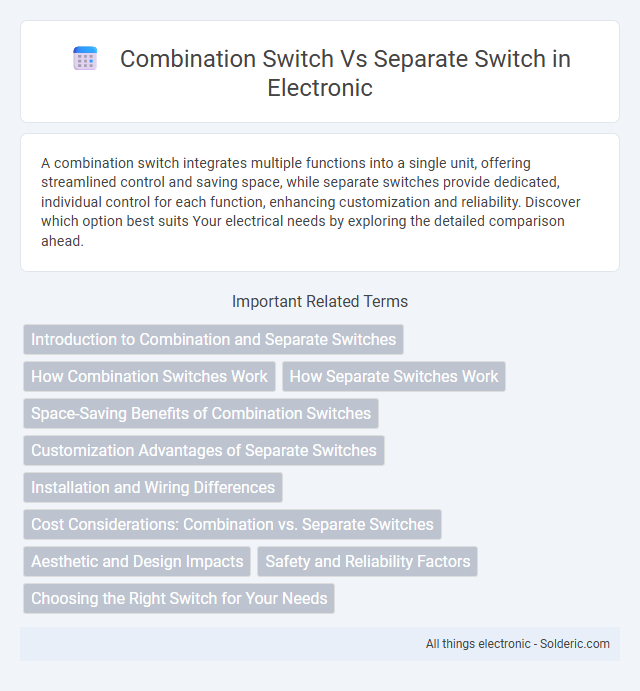A combination switch integrates multiple functions into a single unit, offering streamlined control and saving space, while separate switches provide dedicated, individual control for each function, enhancing customization and reliability. Discover which option best suits Your electrical needs by exploring the detailed comparison ahead.
Comparison Table
| Feature | Combination Switch | Separate Switch |
|---|---|---|
| Definition | Single switch unit controlling multiple functions (e.g., turn signals, lights) | Individual switches each handling a single function separately |
| Installation | Compact, easier installation with fewer connections | Requires multiple installations, more wiring complexity |
| Space Efficiency | Saves space on dashboard or steering column | Consumes more space due to multiple switch units |
| Cost | Generally cost-effective due to fewer parts | Higher cost because of multiple individual components |
| Maintenance | Potentially higher repair cost if combined unit fails | Easier to replace individual faulty switches |
| Functionality | Integrated controls for multi-function operation | Dedicated control for each function; may be more intuitive |
| Reliability | Failure affects multiple functions simultaneously | Failure impacts only the specific function |
Introduction to Combination and Separate Switches
Combination switches integrate multiple functions such as turn signals, headlights, and wipers into a single control unit, streamlining dashboard space and enhancing user convenience. Separate switches allocate distinct functions to individual controls, allowing for more precise adjustments and easier troubleshooting. Your choice between combination and separate switches impacts vehicle ergonomics, installation complexity, and maintenance efficiency.
How Combination Switches Work
Combination switches integrate multiple control functions, such as turn signals, headlights, and wipers, into a single unit, streamlining your vehicle's dashboard and enhancing convenience. These switches operate through a series of interconnected levers and electronic circuits that send signals to their respective systems, enabling simultaneous or independent control without the need for multiple separate switches. This design reduces wiring complexity and improves reliability while allowing you to manage essential functions effortlessly from one location.
How Separate Switches Work
Separate switches operate independently by controlling individual electrical circuits or devices, allowing for precise management of lighting or appliances in specific areas. Each switch sends a direct signal to its designated fixture, reducing the risk of simultaneous activation and enhancing energy efficiency. This setup provides greater flexibility for customization and troubleshooting compared to combination switches.
Space-Saving Benefits of Combination Switches
Combination switches integrate multiple functions into a single unit, significantly reducing the wall space required compared to separate switches. Your electrical installations become cleaner and more organized, freeing up space for other purposes or improving aesthetic appeal. This space-saving benefit is especially valuable in compact rooms or areas with limited wall space.
Customization Advantages of Separate Switches
Separate switches offer superior customization advantages by allowing you to choose specific switches tailored for different functions, enhancing both performance and user experience. This individualized approach enables precise control over actuation force, tactile feedback, and sound, making it ideal for users who demand personalized keyboard settings. Separate switches also facilitate easier maintenance and upgrades, ensuring your setup evolves with your needs.
Installation and Wiring Differences
Combination switches integrate controls for multiple functions like lighting and fans into a single unit, reducing the number of wires and simplifying wall box installation. Separate switches require individual wiring for each function, often increasing complexity and necessitating larger or multiple wall boxes to accommodate additional wiring. Choosing between the two affects overall installation time, wiring labor, and the need for compatible electrical boxes.
Cost Considerations: Combination vs. Separate Switches
Combination switches typically offer a cost-effective solution by integrating multiple functions into a single unit, reducing both material and installation expenses compared to separate switches. Separate switches may incur higher costs due to additional wiring, mounting hardware, and increased labor time required for installation. Evaluating long-term maintenance and potential replacement costs also favors combination switches, as fewer components mean simplified upkeep and lower overall expenditure.
Aesthetic and Design Impacts
Combination switches offer a sleek, minimalist appearance by consolidating multiple controls into a single unit, reducing wall clutter and creating a streamlined aesthetic. Separate switches provide more design flexibility by allowing customization of switch placement and style, which can complement varied interior themes or architectural details. Choosing between combination and separate switches depends on balancing the desire for a clean, modern look against tailored design and user-specific functionality.
Safety and Reliability Factors
Combination switches integrate multiple control functions into a single unit, reducing wiring complexity and potential points of failure, which enhances overall safety and reliability. Separate switches, while offering dedicated control for each function, increase the risk of wiring errors and mechanical wear due to multiple components. You can improve system dependability by carefully evaluating the trade-offs between streamlined design and component independence in your switch selection.
Choosing the Right Switch for Your Needs
Selecting between a combination switch and separate switches depends on your specific electrical requirements and space constraints. Combination switches offer the convenience of controlling multiple functions in a single unit, ideal for compact areas or streamlined control setups. Separate switches provide greater customization and flexibility for complex electrical systems requiring distinct control and isolation of circuits.
combination switch vs separate switch Infographic

 solderic.com
solderic.com